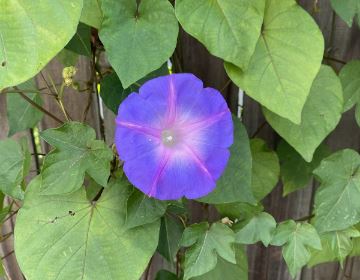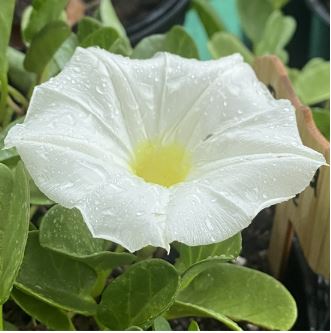
A vibrant ocean blue morning glory exhibiting a variety of leaf structures. (Photo credit: Kaylynn Low)
The theme for our July-August EcoQuest is Convolvulaceae, otherwise known as the morning glory family! This family of plants has over 1,600 species spread across 59 genera that include trees, shrubs, and herbs as well as the vines that most of us are familiar with. A surprising member of this plant family is the sweet potato, which isn’t very closely related to potatoes, which are in the nightshade family Solanaceae!
A characteristic trait of the Convolvulaceae family is the flower shape; more specifically the corolla. Corolla is the collective name for the petals on a flower. The flowers of this family are funnel-shaped, and most of the individual parts are in multiples of five. Ipomoea is the largest genus in this family and hosts the morning glory species that are a common sight in many gardens and natural areas.
In Florida alone, there are 43 native species, along with 27 non-native species, in the Convolvulaceae family. These include morning glories, bindweeds, dawnflower, and dodders. Twenty-six of these species have been recorded in Sarasota and Manatee counties. Only four of them are non-native:
- Water spinach (Ipomoea aquatica)
- Mile-a-minute vine (Ipomoea cairica)
- Bush morning glory (Ipomoea carnea spp. fistulosa)
- Cypress vine (Ipomoea quamoclit)
Some of our more common native varieties that you may be familiar with include:
- Railroad Vine (Ipomoea pes-caprae)
- Moonflower (Ipomoea alba)
- Ocean Blue Morning Glory (Ipomoea indica)
- Tievine (Ipomoea-cordatotriloba)

Beach morning glory in flower after a morning storm. (Photo credit: Kaylynn Low)
A particular non-native species of interest is Water spinach. Water spinach is a commonly grown green originating in Asia, and bush morning glory has only been documented in five counties in the state of Florida, one of which is Manatee County. Of our native species, only one is endangered: scrub morning glory (Bonamia grandiflora). This species is endemic to the state and is only found in central Florida. It prefers sandy scrub habitat and can resprout after fires, which it also needs to maintain a suitable habitat. Threats to Bonamia grandiflora are the same ones that threaten many scrub species, including urban development, citrus growing, and reduction of fire ecology and fire regimes in native areas.
Generally speaking, members of this family can be found in many different habitats ranging from inland scrub to coastal sand dunes and wetlands alike. These plants bloom throughout the warmer seasons in Florida, so it’s safe to say you’ll know them when you see them! Some exceptions, like moonflower or scrub morning glory, only bloom at certain times of day, so be sure to check back if they aren’t flowering when you see them.
If you want to know more about the complexities of Convolvulaceae, please join us on the following dates for a Bioblitz:
July 21 – Pinecraft Park
July 27 – Duette Preserve
August 16 – Crowley Museum & Nature Center
August 25 – Becer Wingate Preserve
You can register for any of these Bioblitzes on the Ecoflora webpage. If you have not already done so, download the iNaturalist app prior to attending and join our Convolvulaceae Ecoquest so that observations of any species in this family will automatically be added to the project once you upload them. We encourage you to also join our Sarasota-Manatee EcoFlora Project page on iNaturalist so that you can contribute any species year-round!
